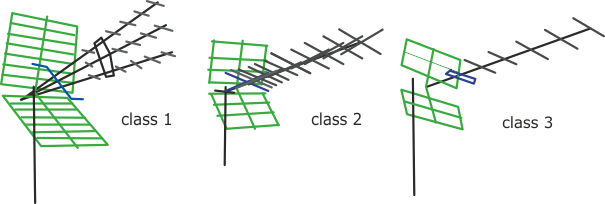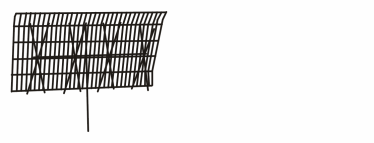Freeview reception - all about aerials
 Brian Butterworth published on UK Free TV
Brian Butterworth published on UK Free TV Updated 8th January 2014.
Your ability of receive all the Freeview transmissions depends on the suitability of aerial
- the design style,
- the "group", and
- its physical location.
Standard type - Yagi aerial

The standard type of TV aerial is known as the Yagi aerial. It is mounted on a pole, and consists of a rod with a reflector (shown green) at the back and many spiky elements (in grey) at the front. The connecting cable connects to the element nearest the reflector, known as the driver (shown in blue).
These Yagi aerials are directional and so pick up signals best from a transmitter that the rod points towards. The more elements the aerial has, the better it picks up a signal and becomes more directional.
A standard-type aerial is all that is required for digital TV reception in most places. These antennae have between 10 and 18 elements and a single reflector. These are recommended for new installations for good digital television reception, but will more often than not function perfectly in good reception areas.
Typically these aerials are designed to receive only some transmission frequencies - see "groups" below.
High Gain aerials

These aerials are designed for poor digital reception areas, and have two reflectors. For maximum signal strength, some digital high gain aerials have up to 100 elements. Since the switchover to digital-only transmissions back in October 2012, most UK households now have good quality digital TV signals.
A more expensive aerial is only required where the signal strength is low, but can often provide the whole Freeview reception where it might otherwise be impossible.
The CAI (that represents aerial installers) has four standards for digital TV aerials. The highest standard "1" is for homes on the fringes of coverage areas, intermediate standard "2" is suitable for use within the coverage area; minimum standard "3" is for good coverage conditions.
These aerials can be either wideband, or receive only selected frequencies - see "groups" below.
Grid

You may haved used a 'Grid aerial' for analogue reception, but as they are generally unsuitable for Freeview reception, they have now generally been replaced by the Yagi type. However in some places a Grid aerial installation may work for Freeview: otherwise replace with a standard Yagi aerial.
Indoor
Indoor aerials are generally not suitable for Freeview reception. In areas of good signal strength it is often possible to receive some transmissions. Even where an aerial works, people often find that may get interruptions to their viewing (or recording).Loft mounted
Loft mounted arrivals are not generally recommended for Freeview reception, as the roof tiles and plumbing will degrade the signal. Some compensation for this loss of signal can be made by using satellite-grade cable to connect the set top box to the aerial.Positioning
The best position for a TV aerial is mounted outdoors, as high from the ground as possible, pointing directly at the transmitter. The signal can be blocked by hills and tall buildings. It should be positioned away from any other aerials.Horizontal or vertical?
The transmitter will either use vertical mode which requires the elements of your aerial to be up-down, or horizontal mode which requires them to be level with the ground.Groups
Both analogue and digital television is transmitted the same group of transmission frequencies (known as channel 21 through to 60). A coloured marking on the aerial shows the group.
To create the best possible analogue picture, TV transmissions from adjacent transmitters have been designated to several different groups of frequencies. By using an aerial that receives only the channels in the correct group, the analogue picture can be kept free from interference.
To receive Freeview transmissions from the same transmitter it has been sometimes necessary to use frequencies that are not part of the transmitter's normal group. When this has occurred, the aerial will need to be replaced with a "wideband" aerial (also known as group W) - one that covers every group.
As Ofcom is planning to move the TV frequencies again - perhaps as soon as 2018 - it may be wise to use a wideband aerial if you can to ensure you can keep viewing Freeview for many years to come.
Help with Television sets?
Friday, 21 May 2021
J
johnjohnson1:33 PM
All terrestrial channels have now disappeared from the Samsung smart TV, only digital signal tv is available. It started with ITV, now its BBC services and all others. The arial is new it was installed les than 6 months ago. The region is Wearside. Pontop Pike receiver.
| link to this comment |
C
Chris.SE10:26 PM
johnjohnson:
Depending on your precise location you may be able to receive several main transmitters, without a full postcode it's not possible to confirm which ones.
If at any time, for any reason, you had loss of signal or badly pixellated signals, whether due to temporary weather conditions, transmitter engineering or faults and you retuned, it will most likely have just cleared the correct tuning. You should never retune when you have any loss of signal.
If you did so, you could have ended up incorrectly tuned to weak and unreliable signals from another transmitter.
There are no current faults or current or recent Planned Engineering listed for Pontop Pike.
But in any event, check for loose connections on your aerial plugs, at the back of the set or any other equipment. Check your aerial is still pointing in the correct direction and the rods (or squashed Xs) are horizontally polarised.
Check in your TV's tuning section that you are tuned to the correct UHF channels for Pontop Pike -
In the multiplex order PSBs1-3, COMs4-7, Local - they are C39, C42, C45, C32, C34, C35, C55, C33
Whether you actually get COM7 or the Local Multiplex will depend on your precise location.
If you find you are incorrectly tuned, often the best bet is to unplug the aerial and do an automatic tune to clear any existing tuning (as no channels should be found), then plug the aerial back in and ideally do a manual tune for the UHF channels listed above, if you can't do that just repeat the automatic tune.
| link to this comment |
Thursday, 18 November 2021
A
Andy Reaney12:33 AM
I recently bought a new LG smart tv with Freeview to replace a 2013 model which died but I'm unable to receive most of the channels
I had before. I'm using the same communal aerial and cable as before but now get no terrestrial or HD channels and fewer radio stations when I auto tune in setting up the TV.
I currently get 57 TV and 12 radio channels my question is there a problem with built in Freeview in 2021 LG models sold exclusively by Currys or is it a problem with LG TV's in general.
| link to this comment |
C
Chris.SE6:00 AM
Andy Reaney:
This does sound a little unusual, there is no particular problems with LG TVs, they are normally very good.
If you provide a full postcode, we can look at the predicted reception for your locale, but more importantly which particular transmitter(s) you might be receiving which means it'd be possible to check the set is tuning to the correct UHF channels. It's also possible that the transmitter may be currently on Planned Engineering so you may not be getting normal signals and auto-tune can sometimes miss signals if they are weaker.
| link to this comment |
Friday, 14 January 2022
Gary Jomae EXPERIENCEING EXACTLY THE SAME THING.
HOW WAS THE PROBLEM RESOLVED?
| link to this comment |
S
StevensOnln110:36 AM
Marlene Hodson: I can't see the comment you're replying to among any of the recent comments on this page. If you could explain the problem you're having, someone may be able to assist.
| link to this comment |
Saturday, 22 January 2022
M
mcflyni10:16 AM
Jules: This is interesting always good to know of the latest tv aerial frequencies so we can get the best coverage
on any tv aerial installations belfast for our customers at belfast tv aerials.
| link to this comment |
Monday, 23 May 2022
For those living in a fringe area and wishing to receive the regional output of both areas is it possible to erect two aerials and divide the input into two different TV receivers to give the viewer the choice just as they used to with the analogue transmissions? Is this possible with only one receiver?
| link to this comment |
S
StevensOnln11:38 PM
Nicholas Anderson: It's possible to combine the signal from two aerials if they don't use overlapping UHF channels. If one region's signal is strong (i.e. being received from a local relay) then you may be able to simply point the aerial at the more distant transmitter and receive the local one off the side lobe. It can easily be done with one receive, the first region will appear on LCNs 1,3,4, etc and the other region will end up in the 800 range.
Although given that the only difference in output between regions in England is usually regional news and the local politics shows, it's probably easier to just watch those on iPlayer or ITV Hub where you can select any region from around the country.
| link to this comment |
Tuesday, 24 May 2022
C
Chris.SE12:57 AM
Nicholas Anderson:
The answer is yes it is, you'd have to use a low-loss splitter in reverse. In the analogue days, adjacent areas had their channels in different aerial groups so you'd use a diplexer. But these digital days, the channels could be in the same group, even adjacent channels!
The only sensible way you could tune those to your precise liking would be if the set(s) have a manual tuning option, you'd tune the multiplexes of primary interest first, then the others will end up in the 800s and if your set has the functionality, you could renumber/move them to LCNs of your choice.
As StevensOnln1 has said, you may not need two aerials, as you may be able to receive one of the transmitters off an aerial side-lobe.
If it's a choice of regional news you are after, providing you don't need/want to watch it at the transmitted time on ITV, it's available on ITV Hub several hours later.
The BBC seems to be a lot quicker these days on iPlayer.
| link to this comment |
Select more comments
Your comment please!